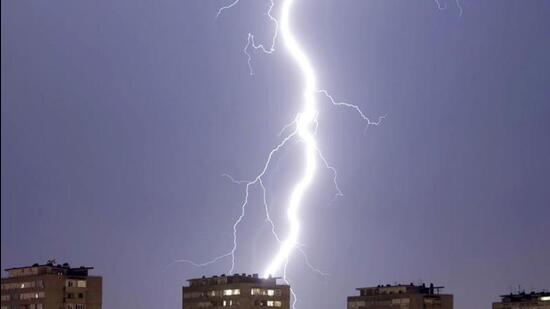IISc develops model to protect aircraft from lightning strikes
Lightning strikes can damage the aircraft surface, lead to temporary disruptions in electrical and electronic systems or even cause permanent damage, the team said. In extreme cases, it can cause ignition of the fuel-air mixture around the engine, leading to an explosion, they added.
Researchers at the Indian Institute of Science (IISc) in Bengaluru have developed a computational model to simulate how lightning can strike an aircraft, they said on Friday.

The team of researchers believes that the insights obtained from the model can help design better lightning protective measures for aircraft.
Lightning strikes can damage the aircraft surface, lead to temporary disruptions in electrical and electronic systems or even cause permanent damage, the team said. In extreme cases, it can cause ignition of the fuel-air mixture around the engine, leading to an explosion, they added.
Udaya Kumar, a professor at the department of electrical engineering, IISc, whose lab has been investigating this phenomenon, said an aircraft is hit by lightning once every 1,000 hours.
“There’ve been many incidents in the last century when the impact of lightning has been catastrophic.”
Kumar’s lab has been studying lightning protection for the past few years. In previous studies, his team analysed the effectiveness of lightning rods in safeguarding tall buildings in a thunderstorm. They have developed models that have addressed several long-standing issues of lightning-current evolution. In the current study and the ongoing work, they have focused on modelling how lightning impacts aircraft to develop suitable protective measures, the IISc said.
The model developed by the IISc team is applied to two different aircraft geometries: a DC10 passenger aircraft and the SDM fighter aircraft model. It involves extensive computation of the electric field around the aircraft and suitable modelling of the electrical discharges. The model and the data obtained from it have been published in the peer-reviewed journal Atmosphere, IISc said.
“With the model, the scientists were able to obtain estimates of the minimum ambient electric field required for initiation of lightning leader discharges from the aircraft. These values, the researchers said, are in good agreement with measured data from instrumented aircraft flown through thunderstorms, such as NASA’s Storm Hazard Program,” the IISc said.
Moreover, it said, the aircraft is not perfectly parallel to the ground during take-off and landing, and the model can simulate how these orientation changes can affect the electric field. The role of atmospheric conditions such as humidity and air pressure are also taken into account in the model. It also showed that aircraft at higher altitudes had a greater affinity for lightning strikes.
In ongoing studies, the team is planning to investigate several related issues. Extending the scope of the study, the team is investigating the peak value of the lightning stroke current required for aircraft-initiated discharge and disruptions caused by the strike to the internal electrical equipment.
“Kumar’s lab has also carried out a first-of-its-kind experiment on a small military aircraft by injecting it with enormous amounts of current – intended to emulate lightning discharge – and by collecting electric field data from inside the aircraft,” the IISc said.
Stay updated Karnataka Election Results 2024 and with all the Breaking News and Latest News from Bengaluru. Click here for comprehensive coverage of top cities including Delhi, Mumbai, Hyderabad, and more across India . Stay informed on the latest happenings in World News.
Stay updated Karnataka Election Results 2024 and with all the Breaking News and Latest News from Bengaluru. Click here for comprehensive coverage of top cities including Delhi, Mumbai, Hyderabad, and more across India . Stay informed on the latest happenings in World News.





